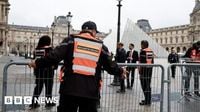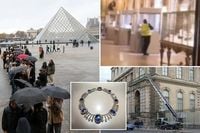Paris awoke to shock and disbelief on Sunday, October 19, 2025, as news broke of a daring daylight heist at the Louvre Museum. In an operation that lasted just minutes, a group of thieves made off with jewels of incalculable historical and cultural value—items belonging to the French Crown Jewels, including treasures once worn by Napoleon III’s wife, Empress Eugénie, Queen Marie-Amelie, and Queen Hortense. The theft has not only rattled the nation but also ignited a fierce political storm, with critics from all corners lambasting the government and its handling of France’s cultural heritage.
According to Sky News, the drama began around 9:30 a.m. local time, when four criminals—disguised as construction workers in yellow reflector vests—arrived at the Louvre. Two came in a truck equipped with a retractable basket lift, while the other two arrived on motorbikes. The gang parked the truck on a road along the River Seine, near ongoing construction, and placed orange cones to secure the area and blend in. Using the lift, they reached a second-floor window, which they cut through with an angle grinder, triggering a security alarm that, curiously, only sounded at the museum’s security headquarters rather than in the gallery itself.
Once inside the Galerie d’Apollon, home to the French Crown Jewels and some of the world’s most famous diamonds, the thieves smashed two display cases—one labeled “Napoleon jewels,” the other “French crown jewels”—and snatched their glittering prizes. Among the eight priceless objects stolen, as listed by the French culture ministry, were a tiara, necklace, and earring from the sets of Queen Marie-Amelie and Queen Hortense; an emerald necklace and matching earrings from Empress Marie Louise; a brooch known as the "reliquary brooch"; the tiara of Empress Eugénie; and her large corsage bow brooch. A ninth item, the crown of Empress Eugénie, was dropped and recovered at the scene, but not before being damaged.
Police say the gang was in and out in just seven minutes—a feat that stunned authorities and the public alike. As AFP reported, the robbers tried to set fire to their mobile ladder before fleeing, but failed. They then hopped on two motorbikes and sped southeast out of Paris toward the A6 highway. No arrests have been made, and as of Monday, October 20, the Louvre remained closed, with refunds offered to disappointed ticket holders.
The theft has been widely described as “the theft of the decade.” Arthur Brand, a renowned art detective, told Sky News, “These crown jewels are so famous, you just cannot sell them. The only thing they can do is melt the silver and gold down, dismantle the diamonds, try to cut them. That’s the way they will probably disappear forever.” He added, “They [the police] have a week. If they catch the thieves, the stuff might still be there. If it takes longer, the loot is probably gone and dismantled. It’s a race against time.”
The Louvre, the world’s most visited museum, typically draws up to 30,000 visitors a day. Its Galerie d’Apollon, rebuilt by Louis XIV after a fire, is not only home to the stolen jewels but also to the Regent diamond—a 140-carat gem renowned for its size and purity, which, thankfully, was left untouched in the heist. The museum’s collection is vast, housing the Mona Lisa, the Venus de Milo, and the Winged Victory of Samothrace, among other treasures. Yet, as history has shown, even the most iconic works are not immune to theft; the Mona Lisa itself was once stolen in 1911, only to be recovered two years later in Florence.
For many, the shock of the Louvre robbery has quickly transformed into outrage. French Justice Minister Gérard Darmanin was blunt in his assessment, telling Radio France, “We failed. People were able to park a furniture hoist in the middle of Paris, get people up it in several minutes to grab priceless jewels.” He added, “There are many museums in Paris, many museums in France, with priceless values in these museums. What is certain is that we failed. The French people all feel like they’ve been robbed.”
Cultural Minister Rachida Dati, meanwhile, faced tough questions about the museum’s security protocols. She explained on Canal News TV that the alarms in the Apollo Gallery only ring at security headquarters, where guards are trained to prioritize visitor safety over artifact protection. This design flaw, she admitted, is a legacy of a time when the Louvre was not built to accommodate 10 million visitors a year or to withstand the sophisticated tactics of modern criminals.
The political fallout has been swift and severe. According to ARTnews, right-wing politicians such as Jordan Bardella, president of the National Rally party, called the theft “an intolerable humiliation for our country,” using the incident as evidence of state decay and institutional neglect. Marine Le Pen, the party’s former leader, described the robbery as “a wound to the French soul,” while Éric Ciotti, former head of the Republicans, warned, “When the State no longer guarantees the security of its treasures, the entire nation is under threat.” Some on the far right also criticized Dati and Louvre director Laurence des Cars, with calls for resignations and accusations—unsupported by evidence—of hiring bias within the museum’s leadership.
The left, too, has voiced criticism, though with a different emphasis. David Belliard, deputy mayor of Paris and a Green Party member, pointed out that museum employees had warned about security flaws months earlier, only to be ignored. François Hollande, the Socialist former president, stressed the importance of reinforcing museum security and going after criminal groups, both domestic and international, that target objects of exceptional value. Communist senator Ian Brossat blamed Dati directly, arguing that ministers should protect operating budgets for cultural institutions rather than undermine them through austerity.
President Emmanuel Macron, whose government had only narrowly survived a no-confidence vote days before the heist, responded forcefully. On X, he declared, “We will recover the works and the perpetrators will be brought to justice. Everything is being done, everywhere, to achieve this.” Macron called the theft “an attack on a heritage that we cherish because it is our history.” The emotional resonance of the crime has even been compared to the 2019 Notre Dame Cathedral fire—a national trauma still fresh in the minds of many French citizens.
With about 60 investigators now working tirelessly on the case, authorities have not ruled out foreign organized crime but are treating the robbery as a domestic affair for now. Forensic work is ongoing, and a detailed list of the stolen items is being compiled. The pressure is on: as Brand warned, the jewels’ fame makes them nearly impossible to sell intact, and the window to recover them before they are dismantled is rapidly closing.
The Louvre robbery has laid bare not only the vulnerabilities of even the most prestigious institutions but also the deep fissures and anxieties running through France’s political and cultural life. As the investigation unfolds, the nation waits, anxious and hopeful, for news that its lost treasures—and a sense of security—can be restored.

